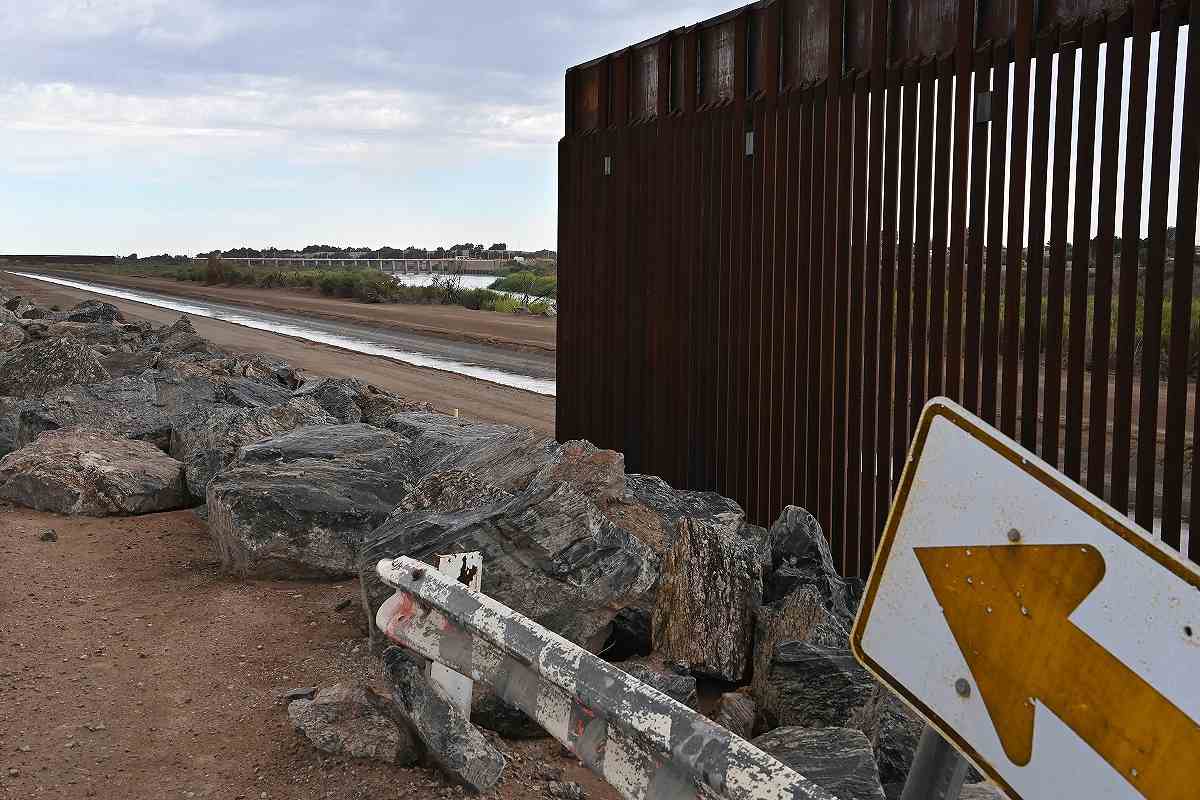
The Colorado River running into Mexico from Yuma, Ariz.
16:25 JST, May 17, 2024
A water dispute between the United States and Mexico that goes back decades is turning increasingly urgent in Texas communities that rely on the Rio Grande. Their leaders are now demanding the Mexican government either share water or face cuts in U.S. aid.
In a deepening diplomatic conflict, Mexico is behind in obligations under an 80-year-old treaty that governs cross-border flows of the drought-stricken Colorado River. It has for decades resisted water deliveries to the United States from its reservoirs in the Rio Grande basin as it faces its own drought pressures on thirsty and valuable crops bound for sale across the border.
But some Texas towns are nearing a breaking point, with two key reservoirs at historic lows.
Water shortages this year already forced a key sugar cane processing plant to shut down, costing the region hundreds of jobs and a major cash crop. And at least one border town faces the prospect of halting new construction, at least temporarily, for lack of water.
Texas leaders are pleading with Secretary of State Antony Blinken to pressure Mexico and calling on Congress to withhold U.S. aid to the country until water flows from behind Mexican dams. At this point, they say, that is their best hope – that, or a hurricane.
“We keep on getting lucky. Right when we’re on the verge of running out of water, we get a tropical storm,” said state Rep. Terry Canales, a Democrat whose district includes the border cities of Edinburg and McAllen. “Eventually, luck runs out.”
A shrinking Rio Grande and a landmark treaty to address water flow
The Rio Grande once flowed as a mighty river from the mountains of southwestern Colorado to the Gulf of Mexico. But centuries of growth and development – and, more recently, a megadrought linked to human-caused warming of the planet – has essentially cut the river in two.
Its upper reach runs nearly dry just past El Paso’s westernmost point. Downstream, rivers that flow from the mountains of northwestern Mexico feed a new section of the Rio Grande along the Texas border – or, at least, they’re supposed to.
Those flows have diminished as Mexico has increasingly dammed its rivers and built new reservoirs since the signing of the 1944 water treaty, Texas water officials said.
The treaty requires that the United States send 1.5 million acre-feet of Colorado River water each year, and that Mexico send 1.75 million acre-feet of water to the United States every five years on the Rio Grande. An acre-foot, enough to spread water across an acre at a depth of 1 foot, is about as much as two to three typical households use in a year, meaning Mexico is supposed to send the United States enough water for about 1 million households each year, on average.
A growing water deficit owed to U.S.
Mexico has fallen behind on making regular deliveries, according to data from the International Boundary and Water Commission, the organization that oversees the two countries’ use of Rio Grande water.
During a five-year water delivery cycle that began in November 2020, Mexico has delivered about as much water as the United States would hope to receive in a single year. Mexico has fallen short on its obligations by hundreds of thousands of acre-feet in nearly every five-year period since 1997.
The treaty does not require Mexico to make regular deliveries, and there is no penalty if it does not meet its five-year targets.
But the lack of steady flows from Mexico has left the U.S. share of waters in Amistad and Falcon reservoirs, which straddle the U.S.-Mexico border, at 28 percent and 12 percent of their capacities just as hot and dry weather sets in.
It’s not that Mexico doesn’t want to deliver the water, said Luis Ribera, a professor and economist with the Texas A&M AgriLife Extension. Both sides of the Rio Grande basin have experienced growing demand for water-intensive crops, booming populations and perennial droughts.
Since the North American Free Trade Agreement came into effect in 1994, northern Mexico has shifted from dry commodities, such as corn, sorghum and cotton, to high-value fruits and vegetables they can sell to U.S. markets, Ribera said. These lucrative crops require far more water to cultivate.
Relatively little is known about how much water is being used by whom in the Rio Grande basin, or how much soaks into unlined canals or evaporates in the heat, said Maria-Elena Giner, the U.S. commissioner of the International Boundary and Water Commission.
That means the water shortages have “just been compounding,” Ribera said.
But it isn’t just a drought crisis – it’s an example of how climate change can complicate international cooperation. And the issue is becoming increasingly political.
A brewing international conflict
Texas’s U.S. senators, both Republicans, and a bipartisan group of eight House members last week urged congressional budget leaders to withhold U.S. aid “until Mexico has agreed to provide more reliable and consistent water deliveries to the United States.”
It follows repeated pleas from state and local Texas officials for Blinken to elevate water among the issues the country pursues with Mexico, such as undocumented immigration and fentanyl trafficking.
“We pray that there is a chance that Mexico will be motivated to make the water deliveries that they owe us,” said Rep. Monica De La Cruz (R). Texas officials have been “pulling every lever possible to ensure that Mexico knows this is an important topic not only for our district but for all of America.”
Until recently, there was hope that a resolution between the two countries was imminent. They negotiated throughout 2023 on a revision to the 1944 water treaty that would have given Mexico more flexibility in making its water deliveries, while also encouraging it to make them more regularly.
Officials with the Mexican counterpart to the boundary and water commission, the Comisión Internacional de Límites y Aguas entre México y Estados Unidos, declined an interview and referred The Washington Post to U.S. officials. Officials at the Mexican embassy in Washington could not be reached for comment.
Ahead of Mexican elections next month, the talks have languished, and opposition in Mexico to a deal has grown. One Mexican senator told the news outlet Milenio that the deal could make irrigation impossible across swaths of the country and would impede growth and development along its northern border.
Border communities such as the city of Mission, Tex., meanwhile, are scrambling to make their limited water supply last as long as possible. City leaders recently considered a proposal to temporarily ban new building permits over water shortage concerns.
Before things get to that point, the city plans to impose a new tiered set of water rates this summer that will mean higher costs once a user exceeds certain levels of water consumption, Mission City Manager Mike Perez said. As precious as water is in this part of the country, it’s so cheap that residents have little incentive to reduce their use, he said.
“We have to start to get people realizing we’re going to have to do something,” Perez said.
Otherwise, the region can only pray for rain. When Mexico has been able to meet its water obligations in the past, it’s been because a hurricane or other tropical system poured on the region. With an active Atlantic hurricane season likely this year, that could mean relief for the Rio Grande.
But if that’s the only plan to escape the water crisis, said Canales, the state representative, it’s no plan at all.
Mounting impacts on both sides of the border
The crisis is causing pain on both sides of the border.
The February closure of a sugar mill in Santa Rosa, Tex., was a red alert that the status quo has changed. Because sugar cane ferments quickly, the loss of the facility means farmers cannot viably grow and sell sugar cane in the Rio Grande Valley anymore.
Citrus producers could be the next to feel major impacts. While their trees can survive a season with minimal water, growers cannot keep going for long without a harvest.
The losses might echo through a region that has seen a surge in warehousing and commerce tied to trade with Mexico. The loss of all irrigated crop production would cost Texas’s lower Rio Grande Valley nearly $500 million in economic activity and about 8,400 jobs, researchers at Texas A&M University reported in December.
In Mexico, farmers’ pain is just as acute. Some occupied a dam in a deadly standoff in 2020 to protest water deliveries to the United States.
Officials in Mexico’s Chihuahua state have been working to improve water conservation and reuse in response to rising demand for both drinking water and irrigation, said Mario Mata Carrasco, executive director of the state’s Central Board of Water and Sanitation.
Water scarcity, he said, is “a global situation that has forced us to make decisions and make investments in new and better water management.”
But that doesn’t ease frustration on the Texas side of the border.
“They’re expanding their irrigated agriculture, and they’re killing ours,” said Sonny Hinojosa, a water advocate who serves on the board of the Rio Grande Regional Water Authority. “They’re growing crops with water that’s rightfully ours.”
Agricultural businesses are facing death by a thousand cuts, said Dante Galeazzi, CEO of the Texas International Produce Association.
For each of them, he said, “You’re at the point now where you’re reaching that thousandth cut.”
"News Services" POPULAR ARTICLE
-

American Playwright Jeremy O. Harris Arrested in Japan on Alleged Drug Smuggling
-

Japan’s Nikkei Stock Average as JGB Yields, Yen Rise on Rate-Hike Bets
-

Japan’s Nikkei Stock Average Licks Wounds after Selloff Sparked by BOJ Hike Bets (UPDATE 1)
-

Japan’s Nikkei Stock Average Buoyed by Stable Yen; SoftBank’s Slide Caps Gains (UPDATE 1)
-

Japanese Bond Yields Zoom, Stocks Slide as Rate Hike Looms
JN ACCESS RANKING
-

Tokyo Economic Security Forum to Hold Inaugural Meeting Amid Tense Global Environment
-

Keidanren Chairman Yoshinobu Tsutsui Visits Kashiwazaki-Kariwa Nuclear Power Plant; Inspects New Emergency Safety System
-

Imports of Rare Earths from China Facing Delays, May Be Caused by Deterioration of Japan-China Relations
-

University of Tokyo Professor Discusses Japanese Economic Security in Interview Ahead of Forum
-

Japan Pulls out of Vietnam Nuclear Project, Complicating Hanoi’s Power Plans
























